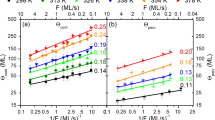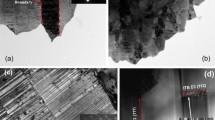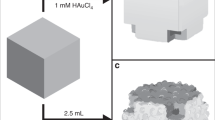Abstract
Thin-sheet (<0.2 mm thick in the direction of diffusion) Au/Ag couples undergo plastic deformation bending during interdiffusion at 750 and 850°; the Ag-rich side forms the concave surface of a deformed couple. This bending is caused primarily by diffusion-induced stress and can be prevented by either mechanical constraint during diffusion or mass constraint of the couple (thicker in the diffusion direction). Because the atomic radii of gold and silver are essentially equal, the stresses cannot arise from lattice parameter gradients. Rather, they are produced by processes (such as dislocation climb) associated with the annihilation and generation of vacancies which accommodate mass displacements within the diffusion zone. These nonconservative processes produce volume changes and corresponding stresses in the diffusion zone which are opposed in the transverse direction (normal to diffusion flow) by the elastic mass constraint of the outlying (especially nondiffused) regions of the couple, thereby creating transverse bending stresses across the couple. A simplified stress analysis indicates that when mass constraint is sufficiently small, the couple undergoes bending primarily by low-stress creep, the transverse stress in the outer fiber of a bent couple being approximately 1 MPa (150 psi). A much smaller, secondary contributor to bending is mass which is displaced in a directional normal to the diffusion flux, but this bend-producing mass displacement accounts for <1 pct of the total mass displaced by the operation of vacancy sinks and sources in the diffusion zone. Therefore, even in the thinnest, bending couples, nearly all (>99 pct) of the mass displacement is parallel to diffusion and this causes substantial marker shifting in all the (bending and nonbending) couples. This strong preference for mass displacement to occur parallel (rather than normal) to diffusion is consistent with both minimal mass constraint and the operation of vacancy sinks and sources in regions of maximum (vacancy) chemical stress.
Similar content being viewed by others
References
L. C.C. da Silva and R. F. Mehl:Trans. AIME, 1951, vol. 191, p. 155.
R. S. Barnes:Proc. Phys. Soc, 1952, vol. 65B, p. 512.
J. Bardeen and C. Herring: inAtom Movements, p. 87, ASM, Cleveland, Ohio, 1951.
J. A. Brinkman:Acta Met., 1955, vol. 3, p. 140.
R. W. Balluffi and L. L. Seigle:Acta Met., 1955, vol. 3, p. 170.
R. W. Balluffi and L. L. Seigle:Acta Met., 1957, vol. 5, p. 449.
J. Bardeen and C. Herring:Imperfections in Nearly Perfect Crystals, p. 261, John Wiley and Sons, New York, N.Y., 1952.
R. W. Balluffi:Acta Met, 1954, vol. 2, p. 194.
A. D. Smigelskas and E. O. Kirkendall:Trans. AIME, 1947, vol. 171, p. 130.
V. Y. Doo and R. W. Balluffi:Acta Met., 1958, vol. 6, p. 428.
J. W. Mathews and W. A. Jesser:J. Vac. Sci. Technol., 1969, vol. 6, no. 4, p. 641.
Y. H. Liu and G. W. Powell:Trans. TMS-AIME, 1967, vol. 239, p. 998.
H. J. Queisser:J. Appl. Phys., 1961, vol. 32, no. 9, p. 1776.
S. Prussin:J. Appl. Phys., 1961, vol. 32, no. 10, p. 1876.
G. H. Schwuttke and H. J. Queisser:J. Appl. Phys., 1962, vol. 33, p. 1540.
R. J. Jaccodine:Appl. Phys. Lett., 1964, vol. 4, no. 6, p. 114.
M. L. Joshi and F. Wilheim:J. Electrochem. Soc, 1965, vol. 112, p. 185.
R. A. McDonald, G. G. Ehlenberger, and T. R. Huffman:Solid State Electron., 1966, vol. 9, p. 807.
W. Czaja:J. Appl. Phys., 1966, vol. 37, p. 3441.
E. Levine, J. Washburn, and G. Thomas:J. Appl. Phys., 1967, vol. 38, p. 81.
Ibid,.
J. L. Lambert:Phys. Status Solidi (a), 1971, vol. 4, p. K33.
K. V. Ravi:Met. Trans., 1972, vol. 3, no. 5, p. 1311.
J. W. Matthews and J. L. Crawford:Phil. Mag., 1966, vol. 11, p. 977.
P. S. Ayres: PhD dissertation, Purdue University, Indiana, 1968.
A. Bolk:Acta Met., 1961, vol. 9, p. 632.
A. J. Goldman, R. W. Jordon, and J. Winter:Trans. TMS-AIME, 1968, vol. 242, p. 295.
A. Kohn, J. Levasseur, J. Philibert, and M. Wanin:Acta Met., 1970,vol. 18, no. 1, p. 163. See especially their Fig. 9.
J. E. Reynolds, B. L. Averbach, and Morris Cohen:Acta Met., 1957, vol. 5, p. 29.
V. Ruth:Trans. TMS-AIME, 1962, vol. 227, p. 778.
M. Hansen:Constitution of Binary Alloys, p. 37, McGraw-Hill, New York, N.Y., 1958.
Y. Quere:Conf. J. Phys. Soc. Jap., 1963, vol. 18, suppl. 111, p. 91.
D. Jeannotte and E. S. Machlin:Phil. Mag., 1963, vol. 8, p. 1835.
L. M. Clarebrough, R. L. Segall, M. H. Loretto, and M. E. Hargreaves:Phil. Mag., 1964, vol. 9, p. 377.
J. L. Ham, R.M. Parke, and A. J. Herzig:Trans. ASM, 1943, vol. 31, p. 849.
T. O. Ziebold and R. E. Ogilvie:Anal. Chem., 1964, vol. 36, no. 2, p. 322.
V. Ruth and G. W. Powell:Acta Met, 1964, vol. 12, no. 2, p. 264.
G. W. Powell:Trans. TMS-AIME, 1965, vol. 233, p. 1906.
B. D. Clay and G. W. Greenwood:Phil. Mag., 1972, vol. 25, no. 2, p. 1201.
W. A. Johnson:Trans. AIME, 1942, vol. 147, p. 331.
F. Garofalo:Fundamentals of Creep and Creep-Rupture in Metals, p. Ill, MacMillan, New York, N.Y., 1965.
L. J. Cuddy:Met. Trans., 1970, vol. 1, p. 395.
H. Warlimont:Z. Metallic., 1959, vol. 50, p. 708.
W. B. Pearson:Lattice Spacings and Structures of Metals and Alloys, vol. 2, p. 80, Pergamon, New York, N.Y., 1967.
O. Kubaschewski and J. A. Catterall:Thermochemical Data of Alloys, p. 65, Pergamon, New York, N.Y., 1956.
F. J. Fraikor and J. P. Hirth:J. Appl. Phys., 1967, vol. 38, no. 5, p. 2312.
O. D. Sherby and P. M. Burke: inProgress in Materials Science, B. Chalmers and W. Hume-Rothery, eds., vol. 13, no. 7, p. 538, Pergamon, New York, N.Y., 1966.
S. M. Makin, A. H. Rowe, and A. P. LeClaire:Proc. Phys. Soc, London, 1957, vol. B70, p. 545.
W. Seith and W. Kottman:Agnew. Chem., 1952, vol. 64, p. 379.
S. Timoshenko and J. N. Goodier:Theory of Elasticity, 2nd ed., p. 399, McGraw-Hill, New York, N.Y., 1951.
Author information
Authors and Affiliations
Additional information
Formerly Graduate Student, Departmentof Metallurgical Engineering, Ohio State University, Columbus, OH43210
Rights and permissions
About this article
Cite this article
Stevens, D.w., POwell, G.w. Diffusion-induced stresses and plastic deformation. Metall Trans A 8, 1531–1541 (1977). https://doi.org/10.1007/BF02644856
Received:
Issue Date:
DOI: https://doi.org/10.1007/BF02644856




